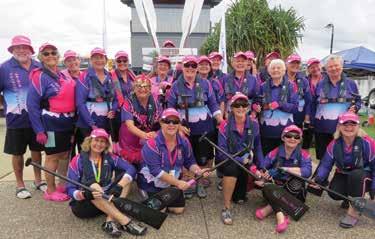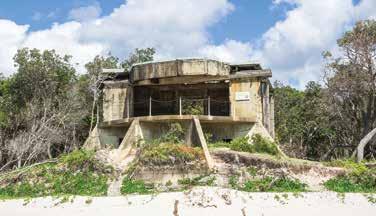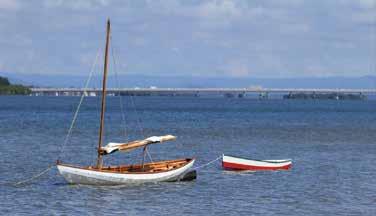
13 minute read
Our Community
from Bribie Magazine 2022
by Tarn Radford
Sunday afternoon, 4pm (ish), heading out under the bridge and away. While the trawler is steaming along, there is gear to get ready for the night’s work – checking the nets and repairing any holes from the last trawl, laying the nets flat on the deck, ready to throw in. “I’ve been trawling since I was 14, I’ve been in this marina since they made it,” Red.
A long night ahead – looking to come back in about 7am tomorrow. Checking the instruments and sounders – looking for 'signs of life' on the floor of the ocean.
Advertisement
Keeping a check on instruments is also about safety - it’s important to be vigilant. Changes in speed can be often heard in the engine – a change in pitch can mean a hook-up with an obstacle on the ocean floor or some other looming disaster, so you have to act fast – reduce revs; winch the nets– now! “Things can get bad really quickly, you have to always listen to the engine,” Joey. After a recent heavy rain, when the lagoons broke through on the island; heading north offshore from Bribie, where you can see the brackish water on the left, the clear oceanic waters on your right. “You don’t just use the sounder to find prawns, you also look for brackish water and other signs,” Joey. Right where the waters meet, following the line – that’s where the prawns will be. Throwing the nets and ready to shoot away! Now, it’s all about making sure there are no tangles or twists in the nets, no hook-ups on the chains or boards. “At that point, it’s all about safety and making sure your gear is set up for the big haul,” Brendon. Lots of company out here; the terns are waiting on the nets to be winched up. Small fish fall out as the net is lifted and swim away, unless a tern gets to it first. Dolphins are always following the boat, too – as well as sharks! Moreton Bay is a big area, but the prawns are often in one spot- trawlers side by side or near each other, so you have to keep watch! Most trawlermen talk between boats – especially about their catches; some boats keep to themselves. A good, clean haul of bay prawns, after a 30 minute 'shot'. Tidy it up, throw back the sidecatch, scoop the rest up with buckets.
You can never tell though; sometimes it’s not prawns, sometimes a big bag of jellies… “They really sting – you have to wear long-sleeves to clear them away,” Joey. Then shoot the gear away again – in the hope of a better catch. Between each shot, hose the deck down with salt-water, to clean it off. Wash the surfaces, check all the gear is in the right places, then sort the prawns into size.
“I feel good seeing this photo – I feel competent and useful. This is my first season – I think it’s a good opportunity for a young person like me. I like being out on the water, looking out over the horizon. I feel safe being on the boat with Bruce – he will know how to fix any problem,” Isaac.
Cooking all through the night – as each catch comes in. 3-5 minutes for a 10kg basket of prawns. Then cool them off in the swim tank, before tipping them into the icebox, to really chill them down in a salty brine. “There are some beautiful times of day sunset, sunrise… it’s always a little relief to see sunrise – the hard parts are over and it’s peaceful, coming back in,” Joey. Coming back under the bridge – time to fold the trawling arms to an exact point, not too tall, not too wide. Aim for the centre of the bridge. Never assume anything – wind, tide, other boaters – it’s never the same as last time. “It’s the most cautious time of the day – I usually 'crab' under the bridge, even on a calm day – always wary,” Joey.
Arms up, nets stowed, welcome home ... the customers are waiting at the dock! Pull out the bagged up prawns, ready to weigh up in buckets and sell to the hungry crowd. Then clean up, go home and sleep – ready to do it all again. “I like working at night and sleeping all day. I’m a bit of a night owl,” Isaac. Bribie Island has some of the tastiest, freshest prawns you’ll ever eat.
Look up Red and Joey’s Trawler, so you know the right time to get to Spinnaker Sound Marina to meet the trawlermen or try 'catching' a few yourself at Savige’s Seafood or at Aussie Meats and Seafoods – it’s all great quality and locally caught, thanks to the hard work of Bribie’s trawlermen!

DRAGONS ABREAST BRIBIE ISLAND
Even in our small community of Bribie Island and surrounding districts, breast cancer has spread its ugly claws to claim many victims. Sadly some of these victims have lost the battle but the majority have survived the trauma of diagnosis, treatment and rehabilitation to lead normal healthy lives. Many of these survivors have experienced the benefits of belonging to Dragons Abreast Bribie Island (DABI). After treatment, transition back into a full and active life is often difficult.
Women who have had breast cancer can often feel isolated and in need of support from other women who have experienced the emotional and physical effects of cancer. The Dragons Abreast movement was founded by Michelle Hanton in the Northern Territory in 1998 to promote ‘Life after Breast Cancer’. There are now approximately 34 clubs throughout Australia. DABI was formed in 2008. Dragons Abreast provides opportunity, through the sport of dragon boating, for rehabilitation after surgery, fitness, emotional support and best of all, wonderful camaraderie. DABI welcomes anyone in our area who has had a breast cancer diagnosis regardless of gender, age, shape, fitness level or sporting experience. Dragons Abreast is based on participation and inclusiveness in a supportive environment where those travelling the breast cancer journey gradually develop their fitness levels through taking part in this ancient Chinese sport. The club is highly effective in promoting the message of breast cancer awareness and education through the fun of dragon boat racing. Although we do sometimes compete in dragon boat regattas our focus is not on winning but on having fun. We consider ourselves winners already, having survived and beaten breast cancer. We now have 52 members and they have all reaped the rewards from being part of this group. We paddle three times a week on our beautiful Pumicestone Passage and are often joined by dolphins, turtles, pelicans and the occasional dugong. Originally we had just one dragon boat, a 20 seater named ‘Spirit of Bribie’, but have now added a 10 seater, ‘Little Spirit’, to accommodate the large growth in membership over the last 2 years. Many DABI members have travelled together both nationally and internationally (at their own expense) to regatta events, seeing new places and forging lasting friendships. Our members range in age from 51 to 93 and you won’t believe the fun and friendship they experience while out in the dragon boat. For further information visit www.dragonsabreast.com.au For information about paddling sessions contact Lyn on 0409 721 464 or email bribiepinkdragons@gmail.com Fishing is Australia’s most popular pastime so maybe it`s time to gather the family and wet a line. The Pumicestone Passage at Bribie island is one of south east Queensland’s premier fishing spots as well as being a marine national park. The Pumicestone Passage is approximately 34 km long from the southern end of Bribie Island to the Caloundra Broadwater including many creeks that run both into the mainland and the island. Known for its wide variety of wildlife the passage is also known for its fishing and is host to a huge variety of estuary species as well as some of our best table fish such as snapper, sweet lip, mangrove jack and of cause mud crabs.
But for now we will concentrate on the most commonly caught estuary species and a few spots and hints on how to take home a feed of fresh fish.
Bream: These fish inhabit rocky outcrops, oyster beds or submerged structures such as jetties or bridges. Use a running sinker with a trace about 500mm from your swivel to the hook and a size 4 bream hook. When you hook a bream always keep the line tight to prevent your fish from spitting the hook. Bait: Prawns, yabbies and mullet flesh. Flathead: You want to fish a sand or mud bottom and to increase your chances fish on the down tide side of the banks as flathead feed on bait as it’s washed into the deeper water or in the mouth of a creek on the run out tide. Rig your line once again with a running sinker and a trace about 800mm long from the swivel to a long shank size 2 flathead hook. This fish is an expert at shaking the hook loose just as you get him close so keep your line tight after you hook him or if in a boat keep a landing net at the ready. Bait: Hardie heads, yabbies and prawns. Whiting: Probably the most prolific local species and easiest to catch is the summer whiting not to mention its excellent eating qualities. Sand is the magic word for this fish, habituating sandy foreshores, surf beaches and sandbanks. Rig your line with a small sinker and a trace about 400mm from the swivel to a long shank size 4 whiting hook and thread your bait on so the end of the hook is exposed at the bottom. Bait: Live worms and yabbies. Sandcrabs: If you decide to go out on the water in a friend’s boat or hire a boat from one of the hire boat services around the passage it is worth the few dollars at the tackle shop to invest in a crab pot as a crab or two will go well with your fish. Set your pot just off the edge of a sand bank or on a weed bed and you are almost assured of a crab. A trap should be checked every 2 hours for best results and allow plenty of rope and a brightly coloured float. Bait: Mullet whole or frames. Mudcrabs: Top of the list on most people’s menu would have to be the world famous muddy, not easy to find but definitely worth a shot. Place your crab pot up in a creek close to the side with the most mangrove trees. Mudcrabs dig into the steep banks under the shade of these trees and generally like shade or murky water. Your pot should be checked every 3 hours and if you have small or female crabs remove them from your pot as they will scare off other crabs. One last thing, watch your fingers with those claws they are extremely powerful. Bait: Mullet cut in halves or any fresh fish frames. Lastly folks don`t forget the three “S”s , Size, sunscreen and safety. Boating and fisheries officers are patrolling day and night so grab a size chart from your tackle shop and please release all undersize fish as soon as possible. With this great Queensland weather sunscreen should be a part of any responsible fishermen’s tackle. If you intend going boating safety gear is just that, SAFETY GEAR, have it, use it and look after it.
If you have ever seen that ear to ear smile on a small child’s face when he catches his first fish then you can imagine why fishing is our biggest pastime, so get your camera and gear and go “FISHING” and have a great day out at Bribie Island.
Bribie Island is the most northern island in Moreton Bay and the third largest. Bribie has been attracting day trippers and holiday makers for many years and the beauty and charm of Bribie Island is still here for you to explore and enjoy. For the first 70 years of European settlement Bribie was an isolated spot and the main inhabitants and visitors were recreational fishermen and oyster farmers. In 1912 a jetty was constructed at Bongaree and the SS Koopa began cruises from Brisbane, stopping at Redcliffe on the way before coming to Bribie. Bribie was a very popular place to visit in the 1930s with day-trippers coming in large numbers to the island. This brought a certain amount of growth to the island and the first shops opened for business along with guesthouses, churches and a bowling club. The first sight that greeted the passengers arriving on the Koopa was what was affectionately known as the twelve apostles. These were the cottages on the Bongaree foreshore that were owned by the Moreton Bay Tug Company and were rented to holiday makers for two shillings and sixpence a week. At this time there was no bridge to connect Bribie and when the Koopa arrived it would usually be filled to capacity with tourists, especially in the school holidays. This could mean at least 1000 people on board. They would fill the foreshore of Bongaree with tents and enjoy what we still enjoy here today.

The outbreak of World War II in 1939 brought everything to a halt. Bribie Island became a military zone and civilians were no longer allowed access. A small number of locals were allowed to stay, mostly those with established businesses or services that were required for the military. Bunkers and machine gun nests were built and Bribie’s beaches were used to train Australian and American troops for amphibious landings. Thankfully, when the war was over, Bribie’s reputation as a day-trip destination once again became popular. The relative isolation of Bribie ended when the island became accessible to all with the opening of the Bribie Bridge in 1963. The bridge proved so popular with visitors that the toll charges paid off the bridge in only five years. It also made Bribie the only island in Moreton Bay that was connected to the mainland and this led to an influx of visitors, holiday makers and retirees.

Today Bribie still enjoys that reputation as the perfect day trip or holiday and being just 20 minutes off the Bruce Higway adds to that appeal. An interesting way to learn about history on Bribie is by visiting the ‘talking monuments’ on the island. There are three located in different areas. One at the end of Solander Esplanade at Banksia Beach, it talks about the landing of Matthew Flinders on Bribie Island. Next to the Volunteer Marine Rescue building at Bellara you will hear some general history of the island and at the Community Arts Centre on Sunderland Drive the history of the aboriginals on the island is retold. Water activities remain popular so if you have your boat you can choose the perfect spot for launching it. Wildlife on Bribie is varied and interesting. Birdlife abounds at Kakadu Bird Roost and Buckley’s Hole Environmental Park. Visit these areas to see the migrating birds that travel from Siberia to feed here in the summer months and rest in our mangroves and wetlands. The population of black swans around Bribie has increased in the last year and are now spotted closer to the main part of Bribie. The pelicans are firm favourites, not hard to spot but great fun to watch. Seeing them running along the water to take off always seems a wonderful feat for this large bird. In the water the most common animals spotted are dolphins, dugongs and turtles. The dugongs and turtles are usually quick to duck back down under the water but the dolphins sometimes put on a great show.
So we invite you to come and enjoy the beauty of Bribie Island where you can make your visit as busy or as relaxed as you want, we have it all here waiting for you.









